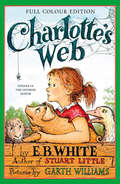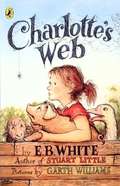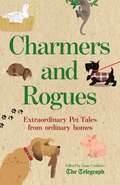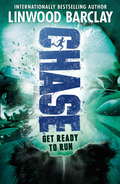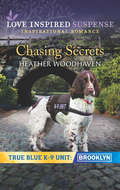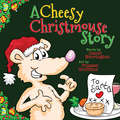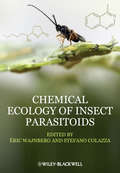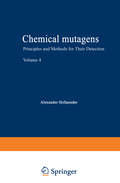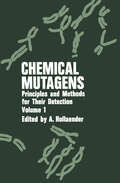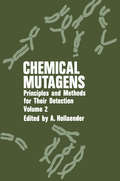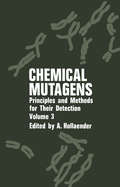- Table View
- List View
Charlotte’s Web: Musical (Charlotte's Web Ser.)
by E. B. WhiteThe much-loved children’s classic by E.B. White, available in eBook for the very first time!
Charlotte's Web (PDF)
by E. B. White Garth WilliamsThe tale of how a little girl named Fern, with the help of a friendly spider, saved her pig Wilbur from the usual fate of nice fat little pigs.
A Charm of Goldfinches and Other Collective Nouns
by Matt SewellA charm of goldfinches, an ascension of larks, a school of dolphins, a cloud of bats, a murder of crows. All these and more are portrayed in this enchanting new book by much loved artist Matt Sewell, playing on the theme of collective nouns for animals. Illustrated with Matt’s inimitable watercolours, and imbued with a love of his subjects that will resonate with people everywhere and of all ages, this book is a great gift for nature and art lovers. Accompanying each illustration is a playful, quirky description of each groups' personality that readers cannot help but smile at. Sewell's unique witty take on the subject, and delicately vivid illustrations make for a lovely addition to his collection of pocketable books.
Charmers and Rogues: Pet Tales
by Anne CuthbertsonThis first collection of Pet Tales, compiled by former Life editor Anne Cuthbertson, features a talking dog and a surfboarding cat, a chicken that thinks it's human, a foul-tempered duck called Mussolini, a bear called Tina, and an escaped cornsnake who may still be at large under the floorboards.Readers will adore the cast of quirky, sympathetic, heroic and adorable characters, including Lovable Rogues, Timid Souls, Hunters and Gatherers, Escape Artists, Givers of Joy and Dearly Departed.With a foreword by the dog-lover, television presenter and adventurer Ben Fogle, this heart-warming, hilarious and at times heart-breaking book is a must for anyone who has ever loved a pet.The Pet Tales column of the Sunday Telegraph launched in 2010, giving readers the opportunity to send in their own stories and pictures. It quickly developed a devoted following with close to a thousand submissions to date.
Chase: Book 1 (Chase #1)
by Linwood BarclayGet ready to run . . . an edge-of-your-seat thriller with bite from international bestselling author Linwood Barclay, in his first novel for 9-12 year olds.Chipper is a very special dog. As part of a top-secret, multi-million dollar experiment to create the ultimate canine spy technology, Chipper's whole life has been spent within the walls of a secret organization known only as The Institute. Chipper is supposed to be more machine than mutt, but something's wrong and The Institute knows it. He's about to be terminated.Across the state, twelve-year-old orphan Jeff Conway is working all hours at his aunt Flo's lakeside cabin business. He misses his parents, his old life, and the dog he had to leave behind.When Chipper escapes and his and Jeff's paths collide, dog and boy find themselves tangled up in the most dangerous game of chase imaginable...Winner of the Arthur Ellis award for Best Kid's Crime NovelDanger, secrets and thrilling suspense in Linwood Barclay's action-packed first novel for children.
Chasing Secrets: True Blue K-9 Unit: Brooklyn (True Blue K-9 Unit: Brooklyn #2)
by Heather WoodhavenWhen a witness becomes a target…Can this K-9 track down the killer?
Cheats and Deceits: How Animals and Plants Exploit and Mislead
by Martin StevensIn nature, trickery and deception are widespread. Animals and plants mimic other objects or species in the environment for protection, trick other species into rearing their young, lure prey to their death, and deceive potential mates for reproduction. Cuckoos lay eggs carefully matched to their host's own clutch. Harmless butterflies mimic the wing patterning of a poisonous butterfly to avoid being eaten. The deep-sea angler fish hangs a glowing, fleshy lure in front of its mouth to draw the attention of potential prey, while some male fish alter their appearance to look like females in order to sneak past rivals in mating. Some orchids develop the smell of female insects in order to attract pollinators, while carnivorous plants lure insects to their death with colourful displays. In this book, Martin Stevens describes the remarkable range of such adaptations in nature, and considers how they have evolved, and become increasingly perfected as part of an arms race between predator and prey or host and parasite. He explores the work of naturalists and biologists from Alfred Russel Wallace to current research, showing how scientists find ways of testing the impact of particular behaviours and colourings on the animals it is meant to fool, as opposed to our human perceptions. Drawing on a wide range of examples, Stevens considers what deception tells us about the process of evolution and adaptation.
Cheddar Gorge: A Book Of English Cheeses
by John SquireWhere can you read about a monstrous cheese big enough to hold a girl of 13 inside? Or that the invention of the bicycle directly, and poorly, impacted sales of cheddar? Or that some of the first cheese makers hid gold coins inside their wheels of dairy as a sales tool? Brethren, the writer calls you this because he hopes that you are 'cheese-minded' like himself. This classic and charming book, a timeless love letter to English cheeses was first published in 1937, newly rediscovered and charmingly illustrated by EH Shepard. It is a treasure trove of wonderful anecdotes including the tale of the monstrous cheese big enough to hold a 13-year-old inside, the Stilton that purred like a cat and the famous cheesemaker in Manchester who selected which Cheshire cheese to sell based on where the mice had been nibbling 'as they were the best judges of a good cheese'. Sir John Squire, a notable journalist of the time, collected together 'a galaxy of talent', with the aim of making this 'one of the most delightful and entertaining gift books that has ever been published'. Each of the distinguished ten contributors champion an individual cheese, setting forward their passionate and compelling arguments, celebrating the differences and delights of each type. Through their explorations, the chequered beauties of the English landscape unfolds. It will certainly whet the appetite for English cheese, for that is ultimately what matters most, as after all 'the only way to learn about cheese is to eat it.'
A Cheesy Christmouse Story (Cheesy Children's Stories)
by David NorringtonFather Christmas is making his rounds, delivering presents on Christmas Eve. He arrives at one house and meets a cheeky mouse who tries to distract him so he can eat his mince pies. This charming story is based on an old poem The Christmas Mouse, and gives it a new twist with fantastic illustrations. A real treat for Christmas.
Cheetah (Large Print)
This page shows a cheetah seen from the side, with its head on the left of the page and tail on the right; it is facing left so only one eye can be found. There is a locator dot shown, which will be at the top left of the page when the image is the right way up.The cheetah is a large cat covered in golden fur and dark spots for camouflage. On the left of the page its small head can be found. Its mouth is open and up from this its nostril and a black camouflage stripe which leads to its eye can be found. Its ear is on the top right of its head at the start of its flexible neck. To the right is its lean body. It stands on four long, slender legs with paws at the bottom of the page. Its walking gait is different to most other mammals, as its legs move in unison. On the right of the page is the cheetah's long tail, with distinctive black stripes at the end.
Cheetah (UEB Contracted)
This page shows a cheetah seen from the side, with its head on the left of the page and tail on the right; it is facing left so only one eye can be found. There is a locator dot shown, which will be at the top left of the page when the image is the right way up.The cheetah is a large cat covered in golden fur and dark spots for camouflage. On the left of the page its small head can be found. Its mouth is open and up from this its nostril and a black camouflage stripe which leads to its eye can be found. Its ear is on the top right of its head at the start of its flexible neck. To the right is its lean body. It stands on four long, slender legs with paws at the bottom of the page. Its walking gait is different to most other mammals, as its legs move in unison. On the right of the page is the cheetah's long tail, with distinctive black stripes at the end.
Cheetah (UEB Uncontracted)
This page shows a cheetah seen from the side, with its head on the left of the page and tail on the right; it is facing left so only one eye can be found. There is a locator dot shown, which will be at the top left of the page when the image is the right way up.The cheetah is a large cat covered in golden fur and dark spots for camouflage. On the left of the page its small head can be found. Its mouth is open and up from this its nostril and a black camouflage stripe which leads to its eye can be found. Its ear is on the top right of its head at the start of its flexible neck. To the right is its lean body. It stands on four long, slender legs with paws at the bottom of the page. Its walking gait is different to most other mammals, as its legs move in unison. On the right of the page is the cheetah's long tail, with distinctive black stripes at the end.
Chemical Anatomy of the Zebrafish Retina: (pdf)
by David Cameron Robert E. Marc Keith M. Studholme Stephen YazullaChemical Carcinogenesis (Nato Science Series A: #52)
by Claudio NicoliniDuring October 18-30, 1981, the second course of the International School of Pure and Applied Biostructure, a NATO Advanced Study Institute, was held at the Ettore Majorana Center for Scientific Culture in Erice, Italy, co-sponsored by the International Union Against Cancer, the Italian League Against Cancer, the Italian Ministry of Public Education, the Italian Ministry of Scientific and Technological Research, the North Atlantic Treaty Organization, the Italian National Research Council, the Sicilian Regional Government and two pharmaceutical Companies (Zambeletti and Farmitalia). The subject of the course was "Chemical Carcino genesis" with participants selected world-wide from 18 different countries. It is now eminently clear that.the bulk of human cancers are related to one of several types of environmental exposure. Of the environmental hazards, chemicals are among the best characterized carcinogens. However, how chemicals induce cancer is still poorly understood. Because of the magnitude of the problem and the ob vious need for a much more critical scientific analysis of the process by which cancer is induced (carcinogenesis), it was highly desirable to expose a greater number of scientists with varying background to some of the latest thinking in chemical carcino genesis. The course had this as its major objective and the re sulting book does reflect it.
Chemical Communication in Crustaceans
by Thomas Breithaupt and Martin ThielThe crustaceans are ecologically and economically important organisms. They constitute one of the dominant invertebrate groups on earth, particularly within the aquatic realm. Crustaceans include some of the preferred scientific model organism, profitable aquaculture specimen, but also invasive nuisance species threatening native animal communities throughout the world. Chemoreception is the most important sensory modality of crustaceans, acquiring important information about their environment and picking up the chemical signals that mediate communication with conspecifics. Significant advances have been made in our understanding of crustacean chemical communication during the past decade. This includes knowledge about the identity, production, transfer, reception and behavioral function of chemical signals in selected crustacean groups. While it is well known that chemical communication is an integral part of the behavioral ecology of most living organisms, the intricate ways in which organisms allocate chemicals in communication remains enigmatic. How does the environment influence the evolution of chemical communication? What are the environmental cues that induce production or release of chemicals? How do individuals economize production and utilization of chemicals? What is the importance of molecule specificity or mix of a molecule cocktail in chemical communication? What is the role of chemical cues in multimodal communication? How does the ontogenetic stage, the sex or the physiological status of an individual affect its reaction to chemical cues? Many of these questions still represent important challenges to biologists.
Chemical Ecology of Insect Parasitoids
by Eric WajnbergInsect parasitoids are a fascinating group of animals in many respects. Perhaps the most fascinating point is that these insects, in the course of the evolutionary time, have developed an impressive way to use chemical compounds to dialogue with the different protagonists of their environment (i.e., conspecifics, their hosts and the plants on which their hosts are living). Unravelling the evolutionary meaning of such chemical communication networks can give new insights into the ecology of these insects and especially on how to improve their use for the control of noxious pests in biological control programmes. Chemical Ecology of Insect Parasitoids is a timely publication, with organised chapters to present the most important knowledge and discoveries that have taken place over the last decade, and their potential use in pest control strategy. Specific relevant case studies are presented to enhance the reader's experience. Suited to graduate students and professional researchers and practitioners in pest management, entomology, evolutionary biology, behavioural ecology, and chemical ecology, this book is essential for anyone needing information on this important group of insects.
Chemical Ecology of Insect Parasitoids
by Eric Wajnberg Stefano ColazzaInsect parasitoids are a fascinating group of animals in many respects. Perhaps the most fascinating point is that these insects, in the course of the evolutionary time, have developed an impressive way to use chemical compounds to dialogue with the different protagonists of their environment (i.e., conspecifics, their hosts and the plants on which their hosts are living). Unravelling the evolutionary meaning of such chemical communication networks can give new insights into the ecology of these insects and especially on how to improve their use for the control of noxious pests in biological control programmes. Chemical Ecology of Insect Parasitoids is a timely publication, with organised chapters to present the most important knowledge and discoveries that have taken place over the last decade, and their potential use in pest control strategy. Specific relevant case studies are presented to enhance the reader's experience. Suited to graduate students and professional researchers and practitioners in pest management, entomology, evolutionary biology, behavioural ecology, and chemical ecology, this book is essential for anyone needing information on this important group of insects.
Chemical Ecology of Insects: Applications and Associations with Plants and Microbes
by Jun TabataInsects have evolved very unique and interesting tactics using chemical signals to survive. Chemical ecology illustrates the working of the biological network by means of chemical analyses. Recent advances in analytical technology have opened the way to a better understanding of the more complicated and abyssal interactions of insects with other organisms including plants and microbes. This book covers recent research on insects and chemical communications and presents the current status about challenges faced by chemical ecologists for the management of pests in agriculture and human health.
Chemical Ecology of Insects: Applications and Associations with Plants and Microbes
by Jun TabataInsects have evolved very unique and interesting tactics using chemical signals to survive. Chemical ecology illustrates the working of the biological network by means of chemical analyses. Recent advances in analytical technology have opened the way to a better understanding of the more complicated and abyssal interactions of insects with other organisms including plants and microbes. This book covers recent research on insects and chemical communications and presents the current status about challenges faced by chemical ecologists for the management of pests in agriculture and human health.
Chemical Ecology of Insects 2
by R.T. Carde W.J. BellDuring the past decade, the study of the chemical structures used by insects has advanced from a subject that could be reviewed in a single volume to a vastly more advanced level. This important new volume brings together a focused group of reviews that offer perspective on the most interesting advances in insect chemical ecology. Chemical Ecology of Insects 2 brings together an internationally respected group of experts covering such topics as chemoreception and integration, orientation mechanisms, plant-insect interactions and insect-insect interactions. An important benefit of these reviews lies in the identification of the boundaries of our current knowledge and the most profitable areas in which we should expect these areas to develop. This important work will appeal to entomologists and ecologists working directly with insects. In addition, plant scientists interested in the interaction of plants and insects will find much valuable information. The book is intended to benefit both field and laboratory researchers as well as advanced students.
Chemical, Microbiological, Health and Comfort Aspects of Indoor Air Quality - State of the Art in SBS (Eurocourses: Chemical and Environmental Science #4)
by Helmut Knöppel Peder WolkoffInterest in indoor air quality (IAQ) is growing at public, political and scientific levels. Complaints about poor IAQ, associated with acute symptoms such as mucous irritation, headaches and bad odor occur frequently, particularly in the office environment, where typical patterns of symptoms often occur, leading to the coining of the term `Sick Building Syndrome'. In the present book, internationally known experts address the following issues: the dynamics of the indoor environment and strategies for indoor measurement chemical and microbiological pollution, important species, sources and detection methods effects of indoor pollution, in particular sensory irritation, including odor airway, eye and skin irritation by organic indoor pollutants and their assessment immune effects, including allergic sensitization chemical hyper-responsiveness controlled human reactions to organic pollutants building investigation: approaches and results source characterization and control criteria, norms and techniques in indoor air pollution, and regulatory aspects. The complex, multifactorial nature of sick building syndrome requires multidisciplinary collaboration from very diverse fields. It is evident that communication between researchers coming from very different areas, all speaking their own language, is a difficult task. This book, presenting as it does the state of the art on sick buildings and how to cure them, is a sound foundation on which to build for the future.
Chemical Mutagens: Principles and Methods for Their Detection Volume 4 (pdf)
by Alexander HollaenderChemical Mutagens: Principles and Methods for Their Detection Volume 1
by Alexander HollaenderAs editor I want especially to thank Dr. Ernst Freese for helpful co operation in preparing these volumes, and to express my appreclatlOn to Drs. Kurt Hirschhorn and Marvin Legator, the other members of the editorial board. Alexander Hollaender January 1971 Preface The purpose of these volumes is to encourage the development and ap plication of testing and monitoring procedures to avert significant human exposure to mutagenic agents. The need for protection against exposure to possibly mutagenic chemicals is only now coming to be generally realized. The recently issued Report of the Secretary's Commission on Pesticides and Their Possible Effects on Health (the Mrak Report-U.S. Department of Health, Education and Welfare, December 1969) has made an important start. Its Panel on Mutagenicity recommends that all currently used pesticides be tested for mutagenicity in several recently developed and relatively simple systems. Whether recommendations such as these are actually put into effect will depend on convincing government, industry, and the public that the problem is important, that the proposed tests would be effective, and that they can be conducted at a cost that is not prohibitive. Why is it important to screen environmental agents for mutagenic activity? To those who will read this book, the answer is self-evident. The sine qua non of all that we value and all that we are is our genetic heritage.
Chemical Mutagens: Principles and Methods for Their Detection: Volume 2
by Alexander HollaenderThe best protection against environmental mutagens is to identify them before they ever come into general use. But it is always possible that some substance will escape detection and affect a large number of persons without this being realized until later generations. This article considers ways in which such a genetic emergency might be promptly detected. A mutation-detecting system should be relevant in that it tests for effects that are as closely related as possible to those that are feared. It should be sensitive enough to detect a moderate increase in mutation rate, able to discover the increase promptly before more damage is done, responsive to various kinds of mutational events, and designed in such a way as to maxi mize the probability that the Gause of an increase can be found. Methods based on germinal mutation necessarily involve enormous numbers of persons and tests. On the other hand, with somatic mutations the individual cell becomes the unit of measurement rather than the in dividual person. For this reason, I think that somatic tests are preferable to germinal tests, despite the fact that it is germinal mutations which are feared.
Chemical Mutagens: Principles and Methods for Their Detection Volume 3
by Alexander HollaenderThe ready acceptance and wide demand for copies of the first two volumes of Chemical Mutagens: Principles and Methods Jar Their Detection have demon strated the need for wider dissemination of information on this timely and urgent subject. Therefore, it was imperative that a third volume be prepared to include more detailed discussions on techniques of some of the methods that were presented from a theoretical point of view in the first two volumes, and to update this rapidly expanding field with current findings and the new developments that have taken place in the past three years. Also included is a special chapter by Dr. Charlotte Auerbach giving the historical background of the discovery of chemical mutagenesis. Methods for recognizing mutagenic compounds in vitro are a necessary preliminary step toward arriving at satisfactory solutions for recognizing significant mutation rates in man, which must be done before our test tube methods of detection can be considered reliable. Two chapters in this volume make important contributions to this problem. Due to the increasing activity in efforts to perfect techniques for detecting chemical mutagens and their effects on man, it is planned to continue this series of volumes as necessary to keep abreast of current findings.
